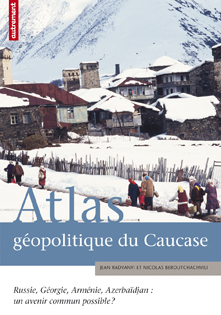26 December 2011
Book review: Atlas Géopolitique du Caucase by Jean Radvanyi and Nicolas Beroutchachvili
 Atlas Géopolitique du Caucase: Russie, Géorgie, Arménie, Azerbaïdjan: un Avenir Commun Possible?
Atlas Géopolitique du Caucase: Russie, Géorgie, Arménie, Azerbaïdjan: un Avenir Commun Possible?
Jean Radvanyi and Nicolas Beroutchachvili
(Cartography: Manana Kourtoubadzé and Philippe Rekacewicz)
Éditions Autrement, Paris
January 2010
80 pages
ISBN: 978-2-7467-1296-6
Many a book designated 'atlas' is not in fact that, but rather a glossy reference work with an occasional map thrown in. Not so the Atlas Géopolitique du Caucase. To be sure, it contains a fair share of running text, but it has maps on most pages, and these form the core of the book.
The Atlas Géopolitique du Caucase is divided into four chapters. The first contains some historical and geographical maps, the second is devoted to the inhabitants of the Caucasus, the third to its economies and the fourth to its conflicts. Apart from the standard political, physical and ethnolinguistic maps, there are plenty of maps not readily available elsewhere. These include a map showing where Europe might end and where Asia start according to various definitions, a map indicating what parts of the Caucasus were vassals of respectively the Turkish, Persian and Russian empires in 1783 and maps comparing the competing Georgian, Armenian and Azerbaijani territorial claims in 1919 and 1920. There are two maps showing the largest and second largest ethnicities per district, thus highlighting the distribution of minorities, such as the widespread Armenian presence in Krasnodar and Stavropol Krais, and the growing Dargin presence in the latter. There are maps indicating the presence of industries, various forms of agriculture, natural parks, tourism and infrastructure. There is even a map indicating Georgian and Armenian pollution along the river Kura and its tributaries.
Some maps stand out for showing different divides within the Caucasus. One map shows that between 1989 and 2002 the Russian population did not just (strongly) decrease in the Non-Russian South Caucasus, but also in Dagestan, Chechnya and to a lesser extend the other North Caucasian Republics except Adygea. Birth rates are high in the east (Azerbaijan, Dagestan, Chechnya and Ingushetia) and low in the west (especially Georgia). Mortality rates are especially high in Krasnodar, Stavropol, Adygea, North Ossetia and Ingushetia (no figures for Chechnya). The result is that population growth is strongly positive in Azerbaijan, Dagestan, Ingushetia and Ajara and negative in Krasnodar, Stavropol, Adygea, North and South Ossetia and large parts of Georgia (outside Ajara).
The book is not perfect. The texts in the Abkhazia and South Ossetia conflict sections lack depth, failing to mention the 'little wars' of 1998 and 2001 in Abkhazia and 2004 in South Ossetia. The chronologies that accompany these and the Nagorno Karabakh sections completely omit the brutal 1918-1920 Georgian-Ossetian war, the 1918 Baku and 1920 Shushi massacres and Stalins terror in Abkhazia, instead devoting space to legal acts.
Overall, Abkhazia, South Ossetia and Nagorno Karabakh form a problem for the Atlas Géopolitique du Caucase. It is understandable, although still regrettable that on a number of maps, some of these states (or Chechnya) turn up grey, there being no figures available. More generally, they don't fit the narrative of many sections, where Georgia, Armenia, Azerbaijan and the Russian Caucasus are compared to one another. In the introduction, the authors indicate that they have decided to ignore their independence, given that they have no international recognition, which is of course patently false, in fact by their own admission elsewhere in the book. More importantly, it would have been useful to pay more attention to Abkhazia, South Ossetia and Nagorno Karabakh, as they can be expected to score differently on many of the indicators compared to Georgia and Azerbaijan.
The sensible thing would have been to include these as independent states, along with indicators that the legality of this independence is widely contested. To be sure, the indicators are still present at the bottom of each map, which feels rather obsessive: Abkhazia is presented no differently from Ajara, and still every map explicitly says that Georgia does not recognise its independence.
That said, these issues don't detract from the fact that the Atlas Géopolitique du Caucase contains many useful and interesting maps. On top of that, it is almost mistake-free and it is designed very elegantly. To name but one detail, every section includes a black disk with Russian, Georgian, Armenian and Azeri translations of its topic. Perhaps it could have been bigger, but as it stands, it is a bargain at a mere €17,–.